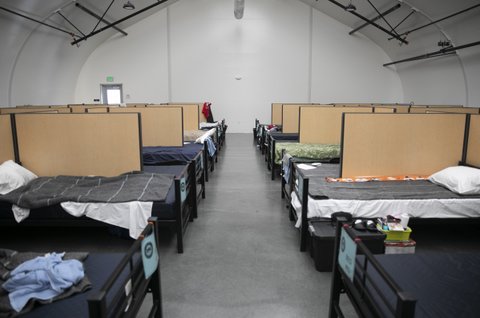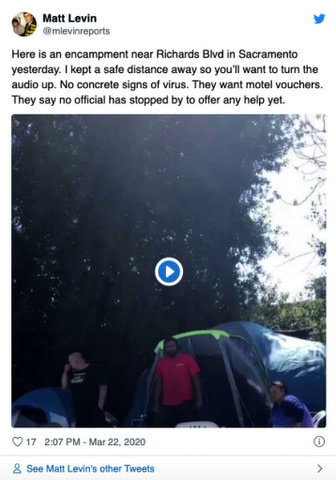
27 Mar California Is Scrambling To House the Homeless. Here’s How It’s Playing Out.

A dorm at Embarcadero SAFE Navigation Center. Photo by Anne Wernikoff for CalMatters
Above: Embarcadero SAFE Navigation Center offers homeless people longer-term shelter in San Francisco. Photo by Anne Wernikoff for CalMatters
By Matt Levin, CalMatters
Chris wants a motel room. So do his neighbors.
Their homes are the dozen or so tents that straddle North B Street in an industrial part of Sacramento. They’re aware that the novel coronavirus is spreading and is potentially lethal. Fortunately, no one in the camp has shown symptoms.
“My friend’s been watching the TV,” said Chris, who declined to give his last name. “He said they’re signing all these bills to put the homeless in a motel, and I’m trying to get one too.”
But it’s unclear when that might happen. As of Tuesday — five days after Gov. Gavin Newsom directed Californians to shelter in place, including the estimated 108,000 who sleep outdoors — nobody had approached the encampment to offer emergency housing, the residents said. Nobody had come around with new protocols the Centers for Disease Control and Prevention had put out about how far apart the tents should be or exactly how to socially distance while living on the street.
In his first remarks to Californians about how the state was planning to grapple with the COVID-19 pandemic, Newsom isolated three populations he would prioritize: the elderly, those with underlying health conditions, and people who are homeless.
Advocates applauded the governor for taking unprecedented action for a particularly vulnerable population: releasing $150 million in emergency funds to local governments and pursuing leases with hotels and motels for temporary shelter.
“This is one of the biggest challenges our homeless system has ever seen,” said Ali Sutton, deputy secretary for homelessness for the Newsom administration. “And our population is one of the most at risk.”
The state’s approach so far has been to let counties and local governments lead on certain measures, with the state lending financial and administrative support. That’s typically the model for homelessness programs in California and across the country.
But with shelters reporting cases of symptomatic people and public health authorities worried about outbreaks in encampments, state authorities are confronting questions of how to speed up help as much as possible and what else can be done.
An example: Of the 950 hotels and motels Newsom said last week could potentially be leased as emergency shelters, Sutton could only confirm that a handful in San Diego County have actually housed homeless people.
Encampments and Sweeps
On Sunday, the federal Centers for Disease Control and Prevention issued guidelines for how local governments should handle an increasingly common staple of California neighborhoods: tent camps.
The CDC recommended that law enforcement not clear people out of those camps unless individual housing units are immediately available. That may seem counterintuitive, as such sites often lack good hygiene facilities and have been associated with the spread of other diseases, like the Hepatitis A outbreaks in San Diego in 2016.

But the nature of the novel coronavirus warrants a different strategy, said Dr. Margot Kushel, a leading homelessness researcher at the University of California at San Francisco, who has been advising the state.
“You don’t want to disperse (the virus) and re-congregate it elsewhere,” Kushel said.
She gave the example of a 50-person camp where someone exhibits symptoms or may have tested positive for coronavirus. That person and others who may be symptomatic should be isolated elsewhere, but everybody else should stay to avoid spreading the infection further.
“If you force them to all regroup — let’s say they went to 25 different places, where they are then encountering other people — then you just spread it to those other places,” Kushel said.
Despite the CDC guidelines and similar instructions from the state, Kushel fears that the federal government may use the pandemic as an excuse to break up encampments.
But Sutton, Newsom’s deputy homelessness secretary, said she doesn’t think California’s local law-enforcement agencies will disobey directives and state officials are having positive discussions with the Trump administration.
A federal court ruling also bars law enforcement from forcibly removing homeless people from sleeping on public property, putting sweeps on dicey legal ground even in the event of a public health emergency.
“We haven’t been hearing as much (talk about sweeps) as we’ve been hearing folks wanting to use this as an opportunity to bring folks indoors in a lot of different ways,” Sutton said.
With directives from public health authorities to allow encampments to remain, keeping them as clean as possible is paramount. Cities and counties are rushing to provide hand-sanitizing stations, portable bathrooms and other facilities.
But amid declining ranks of volunteers — who are sheltering in place or fearful for their own health — and dwindling medical supplies, outreach teams are struggling to get resources to people experiencing homelessness.
Those on North B Street said they’ve received a portable toilet in recent days but no hand-washing stations or other hygiene facilities.
Shelters Try To Cope
The Los Angeles Mission, a homeless shelter near the city’s Skid Row, is waiting for test results.
Two residents exhibited symptoms of the coronavirus in recent days and were quarantined away from others in the 400-bed facility. One was tested, and if the test comes back positive, the ill residents will remain in isolation or, if their conditions worsen, be taken to a hospital.
The shelter has taken extraordinary precautions in recent days to protect its residents, said Ivan Klassen, executive director of the Los Angeles Mission Foundation.
The shelter has spent close to $10,000 on hand sanitizers, hand-washing stations, ultraviolet disinfection devices and thermometers. All who enter the shelter, including staff members, have their temperature taken.
Residents, who typically are allowed to stay two weeks at a time, are being instructed to sleep head-to-toe and are strongly discouraged to go outside.
“We’re not messing around,” said Klassen.
In the patchwork of nonprofit and publicly funded organizations that offer emergency housing in California, some smaller groups are being forced to make difficult choices.
The Union Gospel Mission in Sacramento, which provides rehabilitatory housing to homeless men with drug dependencies, used to have 84 bunk beds available.
To comply with social-distancing guidelines, the organization had to rearrange the dormitory layout, and it now has fewer than 40 beds. Some residents had to leave the shelter in the middle of a pandemic.
“I’ve been here for 15 years,” said Pastor Tim Lane, executive director. “There has never been anything that has compared to this.”
“In economic downturn times, we would just have to cinch up the belt,” he said. “But we weren’t prepared for a pandemic.”
The Newsom administration hopes the $150 million it released earlier this week, as well as $650 million from last year’s budget that is scheduled for release by April 1, can help cities and counties erect new emergency shelters quickly.
The city of Los Angeles announced it was converting 42 recreation centers into homeless shelters last week, hoping to bring 6,000 people in from the street. San Diego plans to convert its convention center into an emergency shelter, partly to relieve other, overcrowded facilities.
The push for hotels
As early as March 15, Newsom said the state was in the process of procuring hotel and motel rooms, hoping “to get people out of encampments and into environments where we can address their growing anxiety and our growing concern about the health of some of our most vulnerable Californians.”
Details of how quickly progress is being made on that goal have been hard to come by. Newsom announced Wednesday that the state and counties had a “portfolio” of 4,305 hotel rooms.
But even with the pandemic clock ticking, it’s taking time to get more hotels on board, or simply get up and running the hotels that have already agreed to leases.
The state announced March 18 that it had helped secure two hotels in Oakland. But neither has yet been occupied by the homeless, according to Lars Eric Holm, a spokesman for Alameda County.
Sutton, Newsom’s deputy secretary of homelessness, said local governments are likely procuring hotels the state isn’t aware of yet, and she characterized the state’s role more as facilitator and supporter of local governments.
“We’re … helping counties through talking with lease options and things like that,” Sutton said. “A lot of this is actually happening at the county level with state support at this point.”
Sutton said the state is in discussions with the Federal Emergency Management Agency about splitting costs for leases, which could be two or three months long with an option for extension. Local governments would be responsible for providing counselors and additional supportive services for higher-needs residents.
The state has provided counties a list of the 950 hotels and motels it has identified and is in the process of refining the list. State officials have declined multiple requests to release the list publicly and directed requests for the names of secured hotels to county officials.
A silver lining?
California has never attempted anything so ambitious to tackle its longstanding homelessness woes.
As the coronavirus spreads, the state is pursuing or considering some of the actions that advocates for the homeless have long called for: purchasing motels, waiving environmental and regulatory hurdles for emergency shelters, expanded federal funding.
Sutton said that if the state can provide emergency housing to thousands that need it in the coming days, it could be the first step toward fixing the homelessness problem.
“In the midst of the emergency, really trying to build systems that potentially allow for transitioning into permanent housing at the end of this is a real opportunity,” he said.
“That is the silver lining I’m trying to hold on to.”
Get the latest on coronavirus in California with our frequently asked questions, dashboard tracking the numbers and our latest updates.
CalMatters.org is a nonprofit, nonpartisan media venture explaining California policies and politics.






No Comments